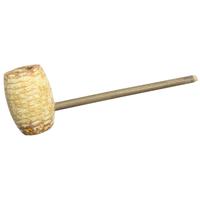Old Dominion: Corn Cob
2 Total
+About Old Dominion
Filter +
Tags +
Filters
Old Dominion pipes began with corn. That much, you might say, is obvious. Specifically however, they began with an heirloom Indian corn which the founders, brothers Bob and Bill Savage, sought to preserve, having discovered it via the single grower whose family had been preserving the breed since 1870. Bill found that this corn produced a uniquely textured and sweet meal when ground, and so the two set out founding Pungo Creek Mills, using antique and vintage equipment to produce a cornmeal that proved a big hit amongst amateur foodies and professional chefs alike.
This of course left them cobs - tons and tons of cobs. The peculiar size and thickness of these cobs (compared to modern yellow corn hybrids) got the brothers to thinking they might be good for pipes. Auspiciously came the accidental discovery of archaeological evidence that their eastern Virginia farmland had indeed been the site of clay pipe production during the Colonial period - along with charred fragments of corn cobs dated back to the 1700s, suggesting cob pipes may have been part of the site's story as well. That cinched it, and so the Savage brothers founded the Old Dominion brand, using the cobs of their unique heirloom corn to produce reed-stemmed pipes that would have been right at home from the 18th century to the earliest days of the 20th.
This of course left them cobs - tons and tons of cobs. The peculiar size and thickness of these cobs (compared to modern yellow corn hybrids) got the brothers to thinking they might be good for pipes. Auspiciously came the accidental discovery of archaeological evidence that their eastern Virginia farmland had indeed been the site of clay pipe production during the Colonial period - along with charred fragments of corn cobs dated back to the 1700s, suggesting cob pipes may have been part of the site's story as well. That cinched it, and so the Savage brothers founded the Old Dominion brand, using the cobs of their unique heirloom corn to produce reed-stemmed pipes that would have been right at home from the 18th century to the earliest days of the 20th.











